THE YELLOW SHARK - EIHN: COUNTERPOINT #2
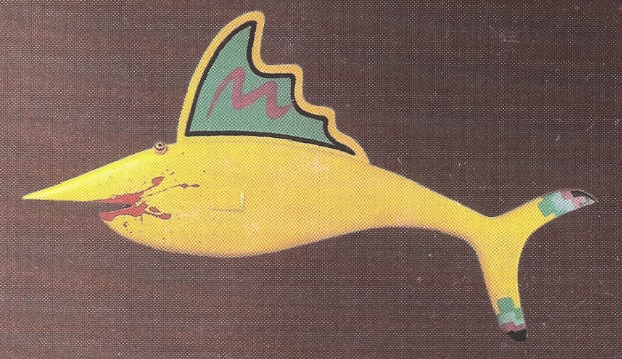 Zappa's late projects show an increasing counterpoint contribution. The late projects being the three synclavier albums and the
successful "The yellow shark" project featuring the Ensemble Modern from 1993. Take for instance the bass line, that plays
through most of "G-spot tornado" (better audible on "Jazz from hell" than on the "The yellow shark" version; see also the fragment
from the Jazz from hell subpage), the second half of "While you were out II" and sections of "Xmas values" and "Times beach II".
To the right the actual fiberglass yellow shark and beneath at the intro the logos of the three concert halls, where the programme was played (Yellow shark booklet).
This yellow shark, a gift, stood beneath the TV in the basement of Zappa's house. When members of the ensemble visited Zappa in 1991 to discuss the programme
it was decided that this yellow shark should be the emblem and title.
Zappa's late projects show an increasing counterpoint contribution. The late projects being the three synclavier albums and the
successful "The yellow shark" project featuring the Ensemble Modern from 1993. Take for instance the bass line, that plays
through most of "G-spot tornado" (better audible on "Jazz from hell" than on the "The yellow shark" version; see also the fragment
from the Jazz from hell subpage), the second half of "While you were out II" and sections of "Xmas values" and "Times beach II".
To the right the actual fiberglass yellow shark and beneath at the intro the logos of the three concert halls, where the programme was played (Yellow shark booklet).
This yellow shark, a gift, stood beneath the TV in the basement of Zappa's house. When members of the ensemble visited Zappa in 1991 to discuss the programme
it was decided that this yellow shark should be the emblem and title.
This section works in conjunction with the "Weasels ripped my flesh: counterpoint #1" section, filling in the picture with
some examples from Zappa's late works.
1) Classical counterpoint.
An example of the classical use of counterpoint is included in the counterpoint #1 section.
In the Orchestral favorites section, I mentioned "Strictly genteel" as a composition where Zappa is applying classical structures. In this case the variations form. A couple of sections from "Strictly genteel" are present in the L.S.O. section. The third counterpart example includes complementary harmonies.
3-4) Counterpoint through multiple layers and counterpoint with shifting harmonies.9/8 Objects - T'Mershi Duween - What will Rumi do?
See also the counterpoint #1 section. Next are other examples of counterpoint with shifting harmonies, where the
melodic lines are playing in a different meters. The first is an exercise
for playing 4/4 and 9/8 simultaneously. The drumset plays a steady 4/4 beat, over which
the marimba and celli play a 9/8 figure in the same tempo. After a while the flute and clarinet
join in with arpeggio figures in 4/4. Brass instruments are playing in triplet time, while
Shankar is improvising on violin. Its recording got released in 1999 on the Zappa Family Trust
release "Everything is healing nicely", often abbreviated to "EIHN" (see also the Ensemble Modern section of the left menu).
"EIHN" knows rehearsal and try-out recordings, next to a lot of improvisations. It wasn't meant for release by Zappa himself,
but some of its episodes can be interesting nevertheless.
The excerpt below is from the most dense section from "9/8 Objects", when
all parts are playing together. The scale is C Phrygian. The chord formed by the 9/8 figure is a fifth plus a
diminished fifth on C or Cm7-9 without the 3rd and 7th.
The notation here is done so that it shows the 9/8 over 4/4 effect, otherwise I would have
notated 4/4 for all parts and let the 9/8 figure shift through it (like in "Echidna's arf (of you)").
I've chosen to let the 9/8 meter start at the first drum beat of the example, but one might just as well opt for letting
the figure start at another point (like the notes that are played first at the beginning).
The first staff is the 9/8 object, the second is Shankar on violin (at first only a vague indication
between brackets, because I can't hear this part properly with everyone else playing). The third staff
contains arpeggio figures, played by a flute, oboe and a clarinet. The fourth staff is played by the brass.
The fifth line is the bass drum beat of the drumset part.
9/8 Objects, section (midi file).
What will Rumi do?, end (midi file).
T'Mershi Duween (1991), section (midi file, tempo change not included).
9/8 Objects, section (transcription).
What will Rumi do?, end (transcription).
T'Mershi Duween (1991), section (notes/transcription).
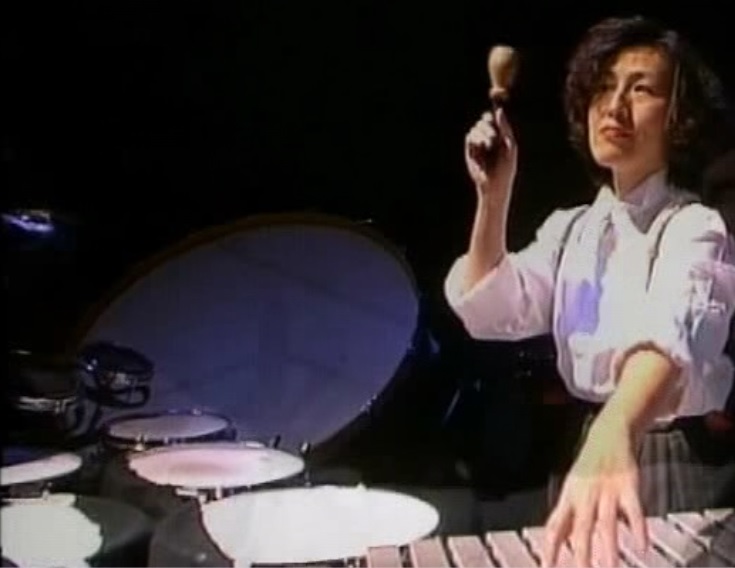 "What will Rumi do?" is another example of such a 9/8 object over 4/4. Here the 9/8 figure is played by the piano. The
composition was made up by Zappa during rehearsals by assigning melody lines to the various sections of the ensemble.
It gets build up layer over layer. The fragment from above is from the end, when everybody is playing. It's going from the
bottom staff of the transcription playing solo, with every few bars a new bar added bottom up. Rumi, being the
percussionist Rumi Ogawa, joins in for the toms part (image of her to the right). At the top the ultimate three-bars closing melody is represented.
The piece has premiered on the Ensemble Modern CD called "Greggery Peccary & other persuasions".
"What will Rumi do?" is one of the clearest examples of Zappa creating a harmonic field. In the final bars
you've got all notes from E Mixolydian mingled, except for the C#. The 9/8 bar forces this field formation upon it explicitly,
because, with its unequal length, it very deliberately seeks to form any harmonic combination with the other parts.
"What will Rumi do?" is another example of such a 9/8 object over 4/4. Here the 9/8 figure is played by the piano. The
composition was made up by Zappa during rehearsals by assigning melody lines to the various sections of the ensemble.
It gets build up layer over layer. The fragment from above is from the end, when everybody is playing. It's going from the
bottom staff of the transcription playing solo, with every few bars a new bar added bottom up. Rumi, being the
percussionist Rumi Ogawa, joins in for the toms part (image of her to the right). At the top the ultimate three-bars closing melody is represented.
The piece has premiered on the Ensemble Modern CD called "Greggery Peccary & other persuasions".
"What will Rumi do?" is one of the clearest examples of Zappa creating a harmonic field. In the final bars
you've got all notes from E Mixolydian mingled, except for the C#. The 9/8 bar forces this field formation upon it explicitly,
because, with its unequal length, it very deliberately seeks to form any harmonic combination with the other parts.
On "EIHN" a variant upon "What will Rumi do?" is included in "T'Mershi Duween". This latter piece was part of the 1974 band
repertoire, only to appear on CD 15 years later on "YCDTOSA vol. II". Its main melody lasts 23/16 in total. A performing
difficulty lays in its reappearance halfway, to be played a tiny bit faster over a 6/4 accompanying figure, thus creating
a 23:24 relationship. The transcription above includes some sections from the 1992 "EIHN" version, performed as follows:
A: The 23-tuplet bar in D Dorian, to be played twice.
B: A figure in 10/16, repeated various times and swelling via doubling and parallel playing.
It starts just on F sharp and
ends as indicated in the transcription, sort of in B minor.
C: After block B has reached its max, the ensemble moves to the "What will Rumi do?" variant, block C. This one also gets build up
in layers, the closing melody from the top staff being played only once just at the end. Next most of the C figure goes to
mezzo-piano and gets used as a vamp for the returning "T'Mershi Duween" melody. The vamp itself is in E Dorian, the top
staff uses the G# from "What will Rumi do?" in E Mixolydian.
This is a test
"This is a test" was handed over to the Ensemble Modern the first day of rehearsals in 1992 because it's
easy to perform and fit for sight reading. Zappa didn't intend this composition to
be officially released. It's a relaxed easy going miniature though and its recording also landed on
"Everything is healing nicely".
This is a test, bars 1-2 (midi file).
This is a test, bars 9-13 (midi file).
This is a test (transcription).
It's a variation piece, where the theme is presented in the first two bars. Then this melody
gets varied upon till the end, leading it through all kind of diatonic scales. The bass
part, played by the brass, is blowing chromatic counterpoint notes through it to season it.
See below at "Exercise #4" for another example of free counterpoint movements.
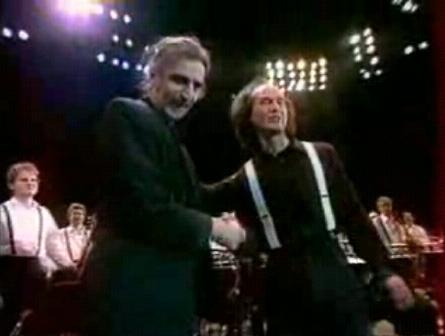 The 1993 "The yellow shark" CD is a sort of a suite for an
ensemble, though not written with that intention, with pieces that are highly diverse in their instrumentation, form and
accessibility. The release contains some of Zappa's most difficult music, written for wind sextet and string quintet, as
well as easier pieces to listen to like "Outrage at Valdez". Three concerts were held in Germany and Austria.
To the right a still from the ZDF TV registration with Zappa and Peter Rundel during applause
in front of the Ensemble Modern.
On the program were also some rearrangements of earlier pieces.
From the counterpoint point of view the final version of "Pound for a brown" (first appearance on the "Uncle Meat" album) is
very interesting because of the different sorts of counterpoint in it: motifs played against a melody at the beginning, bass and descant
playing against each other in the middle section and repeating melodies at the end going from one melody to two and three part counterpoint in layers.
The 1993 "The yellow shark" CD is a sort of a suite for an
ensemble, though not written with that intention, with pieces that are highly diverse in their instrumentation, form and
accessibility. The release contains some of Zappa's most difficult music, written for wind sextet and string quintet, as
well as easier pieces to listen to like "Outrage at Valdez". Three concerts were held in Germany and Austria.
To the right a still from the ZDF TV registration with Zappa and Peter Rundel during applause
in front of the Ensemble Modern.
On the program were also some rearrangements of earlier pieces.
From the counterpoint point of view the final version of "Pound for a brown" (first appearance on the "Uncle Meat" album) is
very interesting because of the different sorts of counterpoint in it: motifs played against a melody at the beginning, bass and descant
playing against each other in the middle section and repeating melodies at the end going from one melody to two and three part counterpoint in layers.
See for instance "Times beach II & III" (below), "Number 6" (You are what you is section), "Gross man" (next section) and "Overture to Uncle Sam". The last composition stems from the ZFT release "Frank Zappa for president". This CD contains another example of atonal counterpoint, called "Medieval ensemble", possibly the most extensive instance of Zappa applying counterpoint. A little outtake from "Medieval ensemble" is included in the Jazz from hell section.
1. Intro
The actual concert, as broadcasted on ZDF TV, began with a nine minutes improvisation piece, presented as the "Overture". First the members of the ensemble come on stage improvising. Next
Zappa walks on stage, all in black, with taped synclavier music being played. He starts with conducting the ensemble. A mixture of directed
improvisations and synclavier outtakes follow. Next Zappa introduces Peter Rundel. The "Overture" in this shape till the introduction of Peter Rundel is included in the
"Zappa - original motion picture soundtrack" CD by the ZFT, released in 2020. Much of the synclavier music became "Dio fa" on "Civilization phaze III".
The intro from the "Yellow shark" CD is from another concert, where Zappa is giving
the audience a secret word for the evening one more time. It's some conceptual continuity type of fun for the Zappa fans in the audience, because he
had done this before during his 1971 tour. The concerts were given on the three locations indicated below, where the three concerts held in Frankfurt were recorded for the CD.
Because of his declining health, Zappa couldn't attend the concerts in full.

2. Dog breath variations
The opening of the "Yellow shark" version of the "Dog breath variations" gets
dealt with in the Uncle Meat section of this study, next to earlier versions. The ones included in this study are:
- Uncle Meat (1969): Dog breath (in the year of the plague).
- Uncle Meat (1969): The dog breath variations.
- Just another band from L.A. (1971): Dog breath.
- The dub room special (1974): Dog breath variations.
- The yellow shark (1992): Dog breath variations.
All can be substantially different. Specific for the 1992 version is its intro, with bars in 9/8 and 11/8 alternating.
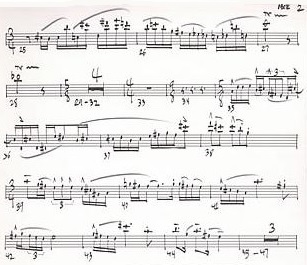
Bars 25-47 from the Oboe part of "Dog/Meat" ("Dog breath" as performed during the years 1972-4).
The example below contains six bars from the 1992 score in a strongly reduced from, to be heard between 0:57 and 1:08. Bars 25-28 contain two-part counterpoint,
as Zappa has also been doing on a much larger scale in the example from the 1974 version, included in this study. In the score these bars are referred to as block C.
As it comes to their melodic formation, these bars are deliberately irregular, while in the other movements patterns can be recognized more readily as it comes to the use
of intervals. Rhythmically the 16th note remains the basis and, regarding scales, it is using notes from one or two keys with only the F/F# changing in appearance.
Dog breath variations (1992), bars 25-30 (midi file).
Dog breath variations (1992), bars 25-30 (score).
It's also an example of Zappa's fondness of larger accompanying chords, as there are:
- bar 25: E-G-B-A-D.
- bar 29: A-B-C#-E-F#, while the string of 32nd notes adds a D, a string of piano notes with open pedal.
- bar 30: E-F#-G-A-B-D.
It's a common practice in Zappa's music that during rehearsals changes could be made. In case of orchestral music and chamber music frequently because
of a limited rehearsal time, but also because he simply liked to do this. In this case it was decided to skip the string of 32nd notes.
In the midi file I left this string in.
3. Uncle Meat
Around 1972 Zappa re-arranged "Uncle Meat (1969)" and "The dog breath
variations" for his jazz ensemble as "Dog/Meat" (see the image below for a sample). This version was also used for the 1974 execution on "YCDTOSA vol. II" and this performance on "Yellow shark".
"Uncle Meat" remains relatively close to the original version from 1969 (see the Uncle Meat section). The main differences are the coda and a different positioning of the accompanying
figure for theme 1.
Uncle Meat (1992), 0:00-0:33 (midi file).
Uncle Meat (1992), 0:00-0:33 (transcription).
In the transcription you can see that the woodblocks deviate from the lead melody during theme 2 (bars 17-21). I didn't
have the original score when I did this transcription, so I couldn't tell for sure if this was prescribed in detail.
In 2022 I did get a chance to look at this score: it deviates in the score too, but not identically.
"Uncle Meat" gets a lot of attention in the Clement study from 2009, that I consider a mix of correct findings and lesser
conclusions. See the left menu for this study and my discussion with Brett Clement. Here I'm briefly summarizing things with some additional remarks.
- Like the 1973-74 version, the 1992 version replaces the sustained bass pedal D by a vamping figure on G. Therefore the key changes from D major/Ionian to G Lydian for theme 1.
The notes involved in the vamp are G-D-E-A, while the figures from staves 2-3 of my 1969 example touch upon all notes of the Ionian scale except C#.
Theme 1 can also be heard in C Mixolydian during the "Uncle Meat variations" from the "Uncle Meat" album (see my Uncle Meat section). Brett calls the later
Lydian version a "correction", because that version is much more in line with his theory (preference for Lydian, general avoidance of Ionian, etc.). You can listen to the 1969 and 1992 versions yourself
and check if it sounds as a correction. Secondly you might then ask why Zappa didn't "correct" theme 2 from major to Lydian too.
- Brett wrote his Lydian theory in 2009. What he couldn't know at that time is that in 1973 Zappa not only re-arranged "Uncle Meat", but also "Exercise #4".
The first minute of "Exercise #4 (1973)" contains variations upon the first theme from "Uncle Meat", utilizing
the Mixolydian mode. It first appeared on CD in 2014 with the ZFT release "Road tapes venue#2". It's included in my Uncle Meat section as well. "Honey, don't you want a man like me?" is another example of using different modes for
the same song over time
(see the YCDTOSA section from this study). In my opinion it has nothing to do with retrospective corrections, looking for the best fitting scale or
whatever adjustments. It's just one of many ways of varying the set-up
of his compositions.
- Brett noted that there's a strong tendency not to use the Lydian tonic in the melodies played on top of this tonic. In the G Lydian version of theme
1, the melody of theme 1 indeed doesn't contain a G. In his 2009 study he gives no musicological reason why Zappa would do that. He just noticed it and the G Lydian
version would be in line with it. According to my findings there's only a weak tendency to do so, thus not strong enough an argument. There may be a relatively lesser
occurrence of tonics in melodies not only in Lydian.
For matter of completeness I have to mention that in his Response to me he does try to give an explanation. On pages 185-186,
he begins with saying: "In Clement 2009, I merely observed the feature of Lydian tonic
avoidance, but was at a loss for an explanation. In Clement 2014 (152),
I introduced the idea of a "tritone restriction", as well as Lydian
properties of consonance and dissonance, that helps explain this factor [etc]."
See the Roxy and elsewhere section from this study at "Son of Orange county" for the details.
Classical music is quite persistent regarding the necessity to confirm the tonic with harmonic cadences, especially as it comes to how to close a piece. In Zappa's
music such necessities don't exist. You've got pieces like the beginning of "Good Lobna" (see the Trance-fusion section), where the tonic doesn't get confirmed
in any manner. Neither melodically by the guitar, nor harmonically by the keyboards. See also Zappa's own comment upon "Heavy duty Judy", that I'm
citing in the Shut up 'n play yer guitar section.
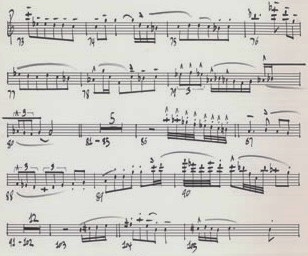
Bars 73-105 from the Oboe part of "Dog/Meat" ("Uncle Meat" as performed during the years 1972-4).
As said, in 2022 I got a chance to look at the original score. It turns out that, for the Ensemble modern, "The dog breath variations" and "Uncle Meat"
got printed as one piece with bars 1-64 being "The dog breath variations" and bars 65-167 being "Uncle Meat". Specific for the 1992 version is the
addition of a coda, that I'm presenting here below. In the score it's section P with bars 154-167.
Uncle Meat (1992), coda (midi file).
Uncle Meat (1992), coda (score).
Bars 155-160 contains figures that are played parallel. The chords of bar 155, beat 1, with their densities (the number of minor seconds distances between the notes):
F-Db-Eb-Ab-C: 8-2-5-4.
G-Eb-F-Bb-D: 8-2-5-4.
Ab-Fb-Gb-Cb-Eb: 8-2-5-4.
Bb-Gb-Ab-Db-F: 8-2-5-4.
This continues all through bars 155-6, thus perfect transpositions of one chord type. The melodic movement then has to be identical too for all parts:
+2+1+2-4+2+1+2-4+2+1+2 etc. (where +2 stand for going up with a major second and -4 for going down with a major third etc., again the number of minor seconds distances,
now for subsequent notes). Each beat the complete figure of the previous beat gets transposed up a minor second. It could be called a mathematical construction like this.
Bars 157-160 also contain just one chord type:
F#-Bb-C-Db-Eb-Gb-Ab: (12+4)-(12+2)-1-2-2-3.
A-Db-Eb-Fb-Gb-Ab-Cb: (12+4)+(12+2)-1-2-2-3.
Etc. The melodic movement is +3-5-5+11+3-5-5+2+3-5-5+12-1+3-5-5+6. Quite obviously
this melody contains variations upon the first motif from theme one from "Uncle Meat" with the returning +3-5-5 movement.
Both chord types are pretty dissonant. The piece ends with four sustained chords, that, again, are of the same chord type:
Ab-C-G-Ab-C-D-Eb-G-Bb-D-Eb-F-Bb: 4-7-1-4-2-1-4-3-4-1-2-5.
Cb-Eb-Bb-Cb-Eb-F-Gb-Bb-Db-F-Gb-Ab-Db: 4-7-1-4-2-1-4-3-4-1-2-5, transposition with +3.
Gb-Bb-F-Gb-Bb-C-Db-F-Ab-C-Db-Eb-Ab: 4-7-1-4-2-1-4-3-4-1-2-5, transposition with -5.
Db-F-C-Db-F-G-Ab-C-Eb-G-Ab-Bb-Eb: 4-7-1-4-2-1-4-3-4-1-2-5, transposition with -5.
These last transpositions, once more, follow the characteristic +3-5-5 movement.
Some notes return in different registers. Upon the Ab of the first chord you could say the following scale is being used:
Ab-Bb-C-D-Eb-F-G. As a chord it's Ab13. All through his career Zappa loved extended chords, sometimes bringing them up to the 13th, as he's doing here.
From bar 161 onwards the music has become diatonic, at first using the notes of Ab Lydian,
contrasting with the chromatic dissonances of the previous two chords.
Next you've got Cb, Gb and Db Lydian. The large arpeggio chords for chords 2-4 (by a piano and harp) are following the same scales.
The one from bar 162 follows B-C#-D#-E#-F#-G#-A#, which is B Lydian (thus the same as Cb Lydian, but notated differently).
The final bar 167 contains the Db13 chord once more, but positioned differently.
4. Outrage at Valdez
There are two quite different pieces that Zappa composed as "Outrage at Valdez"
on behalf of the Jacques Cousteau documentary with the same title. The second one is only known from a radio broadcast, where it got
introduced as "The Valdez score by Frank Zappa". See the previous Documentaries section for examples from both pieces.


Auditorio nacional de Madrid, 2011, with Joan Cerveró conducting "Outrage at Valdez".
5. Times Beach II
The chamber music piece "Times Beach" belongs to Zappa's most inaccessible pieces.
Originally this piece was composed as a five-movement quintet. Movement II got re-arranged as a sextet for the "Yellow shark" by adding a bass clarinet. The members
of the Ensemble Modern, who are playing it, first thought of it as just another modern atonal piece, but started to appreciate it in the long run.
Straight from record it's difficult to transcribe music like this, specifically because there are little clues in it where to put the meter lines.
For both its style and for containing good examples of free atonal counterpoint, I've included a few fragments from "Times Beach" nevertheless. I can't get
the meter/rhythm notation to a level with sufficient certainty to say anything about the meter and rhythm.
Moreover they are existing scores for rent, though not available for the general public. So it's kind of useless to spend much time on transcribing
music like this from CD.
The first example below from "Times Beach II" contains two bars from the second movement, that comprehend a flute and a clarinet (untransposed "C-clarinet"
notation) playing counterpoint figures. Obviously staves one and two follow their own melodic lines. This fragment is too small to say anything about this movement
as a whole, but on a micro-scale you can see that bar 2 is a variation upon the movement from bar 1.
Times Beach II, fragment (midi file).
Times Beach II, fragment (transcription).
Another example from "Times Beach" is included below at track 13, the third movement from this sextet. As a quintet four of its five movements got
premiered in 1985 (see the left menu at On the shelves), but not released on CD. So over half of "Times Beach" exists as sheet music only in the archives
of the ZFT, not even available for rent.
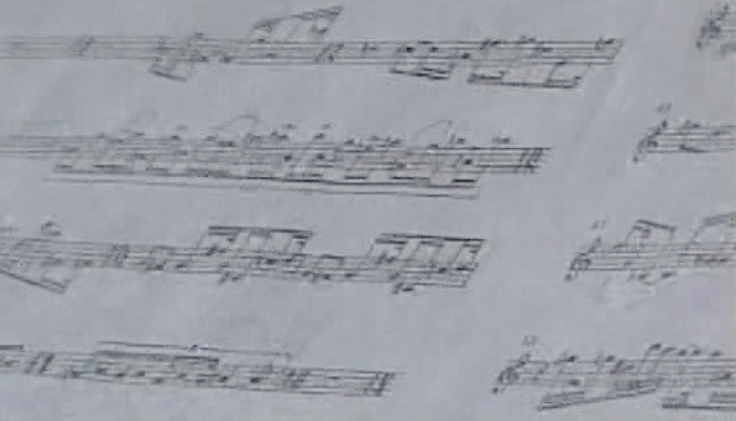
Sample from the oboe part of the "Times Beach II" score (ZDF broadcast, with the camera briefly focusing on the score
in front of the oboe player).
6. III Revised
"III Revised" is a movement from the string quartet "None of the above". See below at track 10 for this composition.
Peter Rundel says: "I like this very much. I think it's wild. The thing is, it's one of the few pieces where you don't have the feel
of rhythm and timing anymore. Which happens quite seldom in Frank's music. I think "III Revised" is quite radical in that way".
It should be noted that the last two synclavier CDs weren't released at that point (see the next two sections), where this effect
is sometimes reached as well.
Indeed "III Revised" is beautiful music, but difficult to come to terms with. It begins gently with a few sustained notes coming
up (bars 1-4 from above), after which the piece is becoming wilder and wilder. For Zappa standards the pauses in bars 2 and 46 are notable. Complete silence
is something rare in his music. He preferred an ongoing stream, often even refusing to pause between songs. Some more about this at "Andy - Is there anything good inside of you", the example
from the 1974 version that you can find in the One size its all section of this study. In that section I'm also mentioning Zappa's admiration of Anton Webern, a composer
known for using pauses as a compositional factor.
There are a couple of pieces by Zappa, where transcribing
with any certainty about the meters is becoming difficult or even impossible. In this case a Youtube film of Ulrich Pöhl conducting
the Ensemble Insomnio came in handy to do a tiny little bit with this composition for my 2019 update (image below). Again, as with "The perfect stranger",
it's not identical to what the Ensemble Modern is playing on CD. In this case it may very well be the revision from quartet to quintet causing this.
III Revised, bars 1-15 (midi file).
III Revised, bars 1-15 (score/transcription).
In 2025 I came across the score itself on YouTube. Bars 1-4 turn out to be notated way more complicated, in fact I think Zappa was trying out something here you could call a rhythmical experiment:
- Bars 1-3: the meter is 4/4, after the initial C a B, A and Ab/G# come up. In the original score not on beat but before beat and off-beat.
Without a drummer, this makes it impossible for a listener to estimate what the meter might be. Only by looking at the conductor of the Ensemble Insomnio in 2019 I could
see that it starts in 4/4.
- Bars 4-6: all parts are using standard notation or different forms of irregular rhythmic groupings in such a way that their notes never pop up at the same moment and that the distances
between them keep varying. With the meter already being unrecognizable, the idea behind this, in my opinion, is to make it sound as a dense and completely arbitrary rhythm to listeners.
When actually performing it part of this experiment was given up, probably because it would cost too much rehearsal time to play it literally as this.
Bar 4 gets played by what goes more or less
as my transcriptions from 2019. It may very well be that there are inaccuracies in it, but, after relistining I still think that at least roughly it gets played like that.
- Bars 7-15: these bars are in 2/4, still notes don't pop up simultaneously, but the distances between them are now notated in an more normal way. You don't have different shapes of irregular groupings on top
of each other anymore. One can also notice that the 2/4 meter is only a notational unit, there is nothing in it to recognize something you might call a downbeat.
Bars 1-15 correspond with 0:00-0:21 on The yellow shark CD. The midi file includes all notes from the score, but lacks all dynamics, nor can my midi editor represent glissando notes well.
This goes for the next example as well, containing bars 35-54. It can be heard between 0:40 and 1:00.
III Revised, bars 35-54 (midi file).
III Revised, bars 35-54 (score).
One of the things that make "III Revised" sound interesting, is its rapid changes in character, as if you're in some sort of musical rollercoaster:
- Bars 35-40: the five parts follow their own melodic lines with most of their notes popping up at different moments. Interval jumps can be large.
The result sounds as a constant rather irregular mixture of counterpoint and hocketing.
- Bars 40-45: out of the blue the quintet continues with playing chords.
a) Bar 40, last eighth note, sustained through bar 42: G-Db-D-Ab.
b) Bar 42, last eighth note, sustained through bar 45: F-A.
c) Bar 45, lasting only a 16th note: F#-Eb-F.
- Bar 45, end, through bar 47, first beat: a pause.
- Bar 47, second beat: four 16th notes for the cello. In this tempo it sound arpeggio-like.
- Bars 47-54: single notes or combination of two notes, all notes being sustained. At this point the composition is very calm, the exact opposite
of bars 4-6.
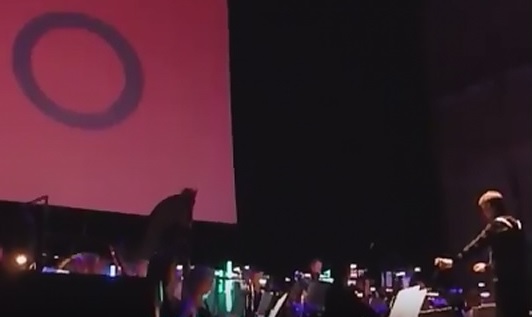
7. The girl in the magnesium dress
Two smaller examples from the score of "The girl in the magnesium dress" are presented in the Perfect stranger section of this study. It's a synclavier piece, that got reworked upon for a score version. Zappa doubted if it would be fit for human performance. The ensemble persisted in performing it. The piano part, not the full score, got published in the Guitar Player special issue Zappa! of 1992, of which I've also included a sample in the Perfect stranger section.
8. Be-bop tango
The opening of the specific "Yellow shark" version of the "Be-bop tango" is coming
by in the Roxy and elsewhere section, where I've included a subsection about Zappa's tangos.

Bars 14-15 from the "Be-bop tango", Ensemble Modern version (reduced). The William Price study
contains most bars in a reduced form. See the Roxy section for more. The "Be-bop tango" is an early
example, where Zappa is applying irregular rhythmic groupings in a systematic manner.
Versions from the following CDs are present in this study:
- Piquantique (1973, from the Beat the boots series, at that time part of "Farther O'blivion").
- Roxy and elsewhere (1974).
- Zappa in New York Deluxe (1976, as part of a "Purple lagoon" performance).
- The Yellow shark (1992).
The differences between these "Be-bop tango" versions are significant. Peter Rundel comments: "What's new about it, aside
from the instrumentation, is a section in the middle where the players sound like jazz musicians doing that jazz talking. Frank
told us to imagine we were suddenly sitting in a restaurant, and had to play the (corny cocktail lounge) restaurant piano,
with people talking and laughing. It's very funny."
9. Ruth is sleeping
"Ruth is sleeping" is the first composition Zappa started with on the synclavier in 1982-3. Rather than beginning with something
easy, he immediately went ahead exploring what a machine could do what would be difficult for humans.
At the time it could operate with
sampled sounds, he chose it to become a piano movement and started reworking upon the score.
Technically the score below can be played on a single piano, but then it would become a circus
act. It would mean that you would have to keep two to four balls in the air with each hand.
The balls in this case are the four to eight melodic
lines, that for performing purposes are divided over two piano parts of two staves.
Each staff is doing sometimes one, sometimes two melodic movements.
The meter in these opening bars is 3/4 with the melodic lines moving through it
irregularly. There are just as much notes on beat, off beat, before beat and after beat. The meter then only serves
as a time unit, there is no downbeat. The formation in the first example is such that there about two sequences of two 16th notes per bar, whereas
the other sequences are slower. It's going from piano to forte, at the end a bit faster. Here it's completely free atonal music,
passing through all registers of a piano.
Ruth is sleeping, opening bars (midi file).
Ruth is sleeping, opening bars (score).
The piece changes in character however frequently. There
are for instance sections that sound like a modern jazz improvisation and sections with larger sequences, where melodic
motifs are getting varied upon. This is happening for instance during bars 57-65, to be continued in bars 69-72 (1:11-1:27 on the CD).
The piece ends with another example of sequences, bars 269-282 (5:15-5:31 on the CD).
An example of a recurring motif at different spots are the cells with repeated 16th notes in bars 18, 34-35 and 38. This becomes
notable, because repeating notes aren't happening elsewhere in this composition in this manner.
The next example are bars 237-245 (4:33-4:44 on the CD). This section might be called an exercise for playing seconds (etude
in French). It's made up of two bass lines plus two sustained notes by the descant at first. These two lines are alternating. While one is taking over playing the
melody, the other is sustaining its last note. You can see little melodic cells that get varied upon. The mostly used interval is the minor second.
Second comes the major second, as in the recurring F-Gb-Ab-F-G natural figure in bars 241-2. Only occasionally other intervals turn up. Bars 237-239 are played in
the lower registers of the piano, bars 240-244 in the lowest registers, going down to C1 in bar 243.
Ruth is sleeping, bars 237-245 (midi file).
Ruth is sleeping, bars 237-245 (score).
To the example I've added the intervals between subsequent notes as the number of minor second steps, as well as I've indicated cells with letters:
- a: little Eb-E step. The Eb always lasts a 16th note, while the length of the longer E note varies and the E can get repeated.
- b: a F-Gb figure at first, with varying tails getting added to it during its returns.
- c: plain chromatic movement, downwards or upwards.
- d: figure around E-Eb-E.
- e: two times a cell with a downwards minor second and minor third, beginning on E and B respectively.
- f and g: two more little figures, not directly related to the previous, as a transition to bar 245. With bar 245 the climate changes again to the
free atonal music as in the opening bars.
Ruth is sleeping, bars 44-53 (midi file).
Ruth is sleeping, bars 44-53 (score).
During bars 44-45 the piece changes in a second from free atonal music to a brief moment of diatonic music. The harmony of bar 45 sounds surprising.
It's the Em7 chord from E Dorian with the descant using this scale as well during bar 45 and the first beat of bar 46. In this example it's mostly
the descant from staff 1, that continues playing a lead melody. Here it's done in a quasi-improvised jazz type manner. From the second beat of bar 46
the music is atonal again. While the previous two examples are notated in 3/4, here Zappa is using 9/8 (one time only), as well as 2/4 (as for several blocks).
Bars 44-53 correspond with 1:00-1:09 on the CD.
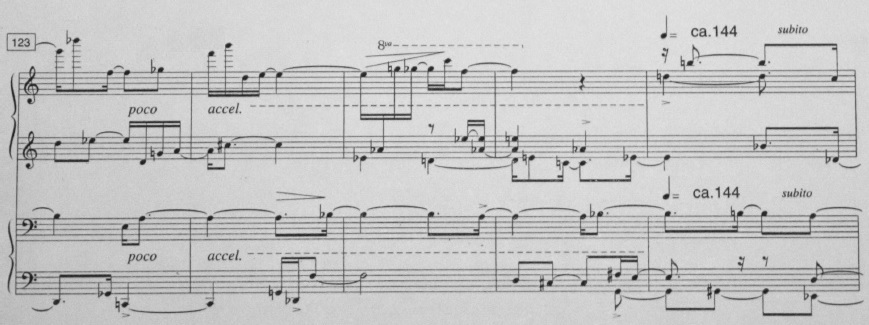
Sample bars from the printed score. The meter is 2/4.
10. None of the above
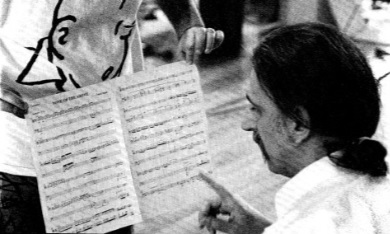 "None of the above" was originally composed as a four-part string quartet for the Kronos Quartet, who premiered this piece in 1985.
As in the case of
"Times Beach", "None of the above" is available for only two of its movements. Image to the right: Zappa in front of a page from "None of the above"
(Yellow shark booklet).
Both pieces are still waiting for a complete recording (see also the
On the shelves section of the left menu). The corresponding tracks are:
"None of the above" was originally composed as a four-part string quartet for the Kronos Quartet, who premiered this piece in 1985.
As in the case of
"Times Beach", "None of the above" is available for only two of its movements. Image to the right: Zappa in front of a page from "None of the above"
(Yellow shark booklet).
Both pieces are still waiting for a complete recording (see also the
On the shelves section of the left menu). The corresponding tracks are:
- String quartet mvt. I => "None of the above" for string quintet.
- String quartet mvt. II: officially existing as sheet music only.
- String quartet mvt. III => "III Revised" for string quintet.
- String quartet mvt. IV: officially existing as sheet music only.
Related are:
- "Questi cazzi di piccione": another string quintet piece from "The yellow shark", regarding style related to "III Revised".
- "None of the above (revised & previsited)": rehearsal sections from "EIHN", starting with the opening of "III Revised". Next this track continues
with string quintet music with additional chamber orchestra embellishments. It sounds like it is recorded in a rather fragmented way with many pauses. The CD liner notes
suggest that next to the expansion for string quintet, some sections were also rewritten for string quintet plus chamber orchestra.
On Youtube bootleg recordings of the 1985 performance of movements II and IV by the Kronos Quartet can be found.
In 1992 The Ensemble Modern had five string players, the reason why Zappa adapted "None of the above" for a string quintet. It's for two violins, and
one viola, violincello and contrabass. The scores of "Times Beach" and "None of the above" are only for rent for ensembles, nor did I found examples elsewhere till 2025.
It's difficult music to transcribe, because the meters are mostly only functioning as time units. There's a lot of counterpoint happening in "III Revised"
and "Questi cazzi di piccione", as well as hocketing. Compared to these two movements and "Times Beach", "None of the above" is much more accessible.
This is accomplished by the formation of sequences and the more homophonic writing style.
None of the above (I), bars 12-18 (midi file).
None of the above (I), bars 27-30 (midi file).
None of the above (I), bars 12-18 (score).
None of the above (I), bars 27-30 (score).
The first example can be heard between 0:23 and 0:45. It contains:
- Bar 12: this is in a way a diatonic bar. It starts with the combination D-F-Bb, as chord Bb (major triad), of which the F and Bb are sustained.
The cello plays D-Eb-F-Gb-Ab-Bb-C upwards. That's not a standard diatonic scale, but it knows only diatonic intervals.
- Bar 13: the melody becomes chromatic. Bars 12-13 contain irregular rhythmic groupings in a 3/4 environment.
- Bars 14-16: the writing style is homophocic with only some brief melodic movements between chords.
- bars 17-18: this is 100 % homophonic, on top of a C pedal, the chord progression is Dbsus2, B, Db and B.
To a point this diatonic, the scale being C-Db-Eb-F-Gb-Ab-B(Cb). Only Ab-B is a minor third. I guess the reason why it's notated as 5/4 plus 3/4 instead of two times 4/4,
is to avoid that the last chord of the 5/4 bar might get an accent.
The second example above is from the middle part of this piece, where the cello is taking the lead, 1:08-1:20. In this case it's atonal.
When I tried to transcribe this in 2016 it wasn't possible for me to be sure who's playing which note,
so I notated this with three staves corresponding with ranges. One staff for the higher descant notes, one for the alt range and one bass staff.
The cello is playing a sequence of mostly downwards moving strings of four notes per bar. The others are complementing the cello part with
mostly harmony notes and occasionally some light counterpoint movement. About the whole example, bars 1-11, is played accelerating
little by little. In 2025 I came across the score itself, which clarifies for instance that Zappa used a different meter notation (see the text below the example for further comments).
The midi example ends with a sustained chord (bar 30 from the original score). It's a broad chord, containing G#-Ab-C-Db-A-E-F#, spread out over four octaves.
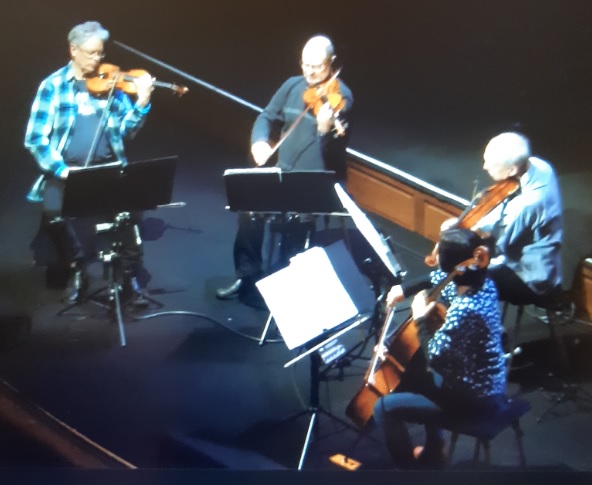
The Kronos quartet rehearsing "None of the above" (still from the Zappa documentary from 2020 by Alex Winter).
Next are two fragments from movements II and IV, based upon the 1985 performance. I can't this above a sketch level. The meters aren't directly recognizable
just by listening to it, nor is the rhythm of the first fragment certain. So that one is notated without meters with only dashed lines.
Maybe one day the original score itself becomes available and something more serious can be done with these two movements. Using recordings, in this case a bootleg, to get
at examples from official scores is something I'm sometimes doing for lack of anything better.
None of the above II, fragment (midi file).
None of the above IV, fragment (midi file).
None of the above II & IV, fragments (sketch).
The character of each of the four movements from "None of the above" is different. While the first movement knows sequences, thus having something classical in its way
of structuring, the second movement is very abstract through-composed atonal music. It sounds as if Zappa avoided forms of regularity during this movement, both as it comes
to melody lines as to the rhythm. The fragment from above can be heard halfway this movement, lasting around 7 seconds (4:32-4:39 on the 1985 recording).
It's way too small to give an idea of this movement, but, like the next fragment, it's examplary of Zappa's writing style for modern music, being a mix of harmonies,
hocketing and, to a lesser degree, counterpoint (as also said elsewhere). The fourth movement does know more standard forms of structuring as varying small cells, like
the high melodic line played by the first violin between 1:02 and 1:15 on the 1985 recording. The second fragment from above from the fourth movement is played
at the end of this movement only a few bars away from this end, lasting around 8 seconds (2:50-2:58 on the 1985 recording).
Though I'm still not sure about the meter notation, at this point the beats can be clearly discerned.
This fragment is less explicitly atonal than the preceding movements II and III, sometimes sounding a bit as fractions from diatonic scales.
11. Pentagon afternoon - Times Beach I & IV
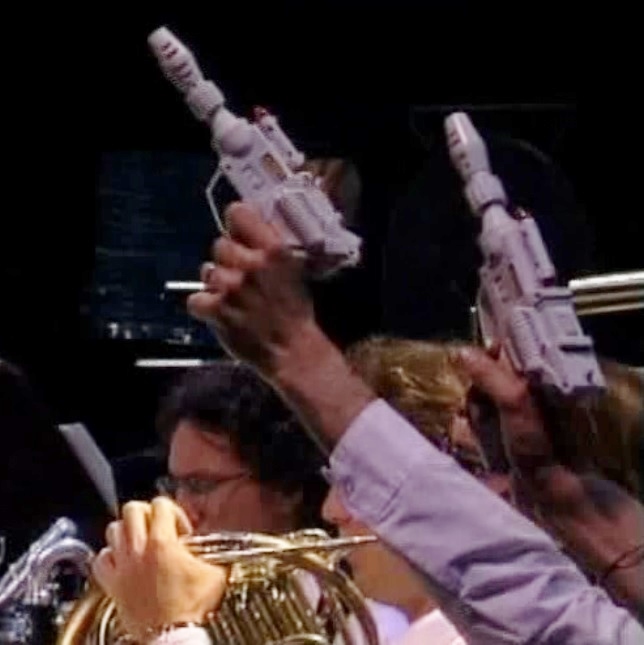 Zappa himself calls "Pentagon afternoon" a tone poem in the CD booklet. The term came in use in the 19th century for works that are trying
to depict a story musically, with the titles indicating the subjects. I this case Zappa explains the little story in the CD booklet.
The ray guns, he's talking about, can actually be heard on stage
during this piece. Peter Rundel says this track is only part of a bigger piece, where they did a lot of work on. Some subdued
annoyment about Zappa's decision to eliminate most of it can be detected.
Zappa himself calls "Pentagon afternoon" a tone poem in the CD booklet. The term came in use in the 19th century for works that are trying
to depict a story musically, with the titles indicating the subjects. I this case Zappa explains the little story in the CD booklet.
The ray guns, he's talking about, can actually be heard on stage
during this piece. Peter Rundel says this track is only part of a bigger piece, where they did a lot of work on. Some subdued
annoyment about Zappa's decision to eliminate most of it can be detected.
Pentagon afternoon, fragment (midi file).
Pentagon afternoon, fragment (transcription).
The fragment from "Pentagon afternoon" from above is played between 1:46 and 1:58, a passage where the meter can be recognized
more easily. It involves the whole ensemble, so some notes might be missing in the transcription. Bars 1-4 are the only episode from this piece with
a returning motif, the remainder is through-composed. The example is too small to say anything substantial about the piece as a whole, but you
can see that it's of the free atonal kind.
Times Beach IV, bars 1-8 (midi file).

In 2018 I could find the opening page from mvt. IV from "Times Beach" on Youtube, posted by Derek Pavlic. Some elements from its opening go similar
to the section from "Pentagon afternoon" from above. Here you can see the original quintet instrumentation:
- Flute.
- Oboe.
- Clarinet in Bb.
- Horn in F.
- Bassoon.
Most scores by Zappa are concert scores with all parts being untransposed. The Songbook knows one example, the excerpt from Music for low budget orchestra,
with a part for Bb clarinet that is transposed. Another example is the Bb clarinet part in his own handwriting, that is included below my "The new brown
clouds" example from the Wazoo section.
A comparison with the bootleg recording of the 1985 performance by the Aspen Wind Quintet indicates that
the page from above is a concert score. So the clarinet and horn parts shouldn't be transposed. On the other hand "Get whitey" does have
a Bb clarinet part, that should be transposed.
The image above has "Copyright © 1985 Frank Zappa Munchkin Music ASCAP" as a footer,
so it looks as the original score itself.
The bootleg recording of the complete 1985 Aspen Wind Quintet performance contains:
- 0:00-3:30 Mvt. I.
- 3:30-9:19 Mvt. II.
- 9:19-13:30 Mvt. III.
- 13:30-21:26 Mvt. IV.
- 21:26-21:38 applause.
The sound quality of the instruments is good (no distortion), though there is much hiss. Movements I and IV are just as good as movements II-III, which
makes this situation frustrating. Of movement V no scores or recordings are publicly available whatsoever. In 2023 I got a chance to look at the full score
of mvt. IV, upon which the following examples are based.
Times Beach IV, bars 61-68 (midi file).
Times Beach IV, bars 61-68 (score).
"Times Beach IV" is through-composed. One can easily recognize the varying of motifs and themes locally, but one can also notice elements returning
over a longer distance. Bars 1-5 begin with quarter notes alternating E-D#, over which the other instruments begin with playing harmony notes.
The examples I'm showing here are instances of this phrase with alternating quarter notes returning in different shapes. Bars 61-65 contain
F#-G alternating. There are a couple of differences between the score I encountered on YouTube and the 1985 performance:
- The G# from staff two is played an octave higher.
- The G natural from bar 63 appears to be a writing error, it should be G-sharp here too. In bar 61 a bow is missing for the Bb.
- The prescribed tempo (72 quarter notes per minute) made it impossible to play strings with 32nd notes, as in bars 66-67, exactly as prescribed. Rather it got approached, allowing notes
to be skipped. Mvt. V from "Times Beach" proved to be impossible to play. Around 1990 the synclavier contained samples of acoustic instruments, good enough
for performing chamber music on it, as "Civilization phaze III" demonstrates, but no attempts were made to release "Times Beach" in this manner.
- The chord from bar 68, Eb-D-E-Gb-F, got replaced by a much less dissonant chord Eb-C-E-Gb-C.
Quite obviously bars 61-65 are variations upon each other. Staff 1 remains the same, but the harmony notes from the other staves pop up
at different spots. In case of staff 3 the variations lie in the accents of the repeating A note. These details were skipped
during the 1985 performance. Very likely these were adaptations done on the spot.
Times Beach IV, bars 100-107 (midi file).
Times Beach IV, bars 100-107 (score).
The idea of alternating notes with a minor second between them is also present during bars 101-106. Eb-D in staff 1 during bars 100-104,
apparently as quarter notes at first. Also here many adaptations were made. Again the 32nd notes from bar 100 for the clarinet could only be touched upon by
both the hobo and clarinet. During bars 103-106 one can see the clarinet alternating G-Ab as eighth notes. Notable is the rhythmic divergence between parts
during 104-106, the effect sounds remarkable.
Times Beach IV, bars 244-253 (midi file).
Times Beach IV, bars 244-253 (score/transcr.).
Bar 251, as I found it on the internet, would be another example of this type of notes alternating, here in the shape of Ab-G by the flute, rhythmically as a 11-tuplet.
This next to A-G# for the bassoon as a sixtuplet, while the clarinet would be playing a melody involving a 9-tuplet. This being preceded by a one-time only bar in 5/16, ending
with a quintuplet. If so, this understandably turned out to be undoable during rehearsals with Zappa rewriting the final bars. Locally, during bars 244-248, one can see
the varying three types of rhythmic figures, all melodic ones being quintuplets, while the bassoon is playing on beat in a standard manner. With rewriting the ensuing bars,
about half of the material remained present in a different set-up, while the other half got eliminated.
Times Beach I, fragment (midi file).
Times Beach I, fragment (transcription).
This last example is a small fragment that you can hear towards the end of Mvt. I, 3:02-3:08 on the 1985 recording. The horn
and bassoon are playing separate melodic lines with the eighth note is time unit. At first the bassoon part is a chromatically
upwards moving line. The flute part is rather free. The clarinet and oboe part sound
as if they are filling this in harmonically. Sometimes the flute, clarinet and oboe are playing rhythmically in line with the horn and bassoon, sometimes it's uneven.
The notes of the horn and bassoon part can be recognized relatively well, the other parts are more difficult to follow.
So again this example is only an approximation with the meters being my notational choice.
12. Questi cazzi di piccione
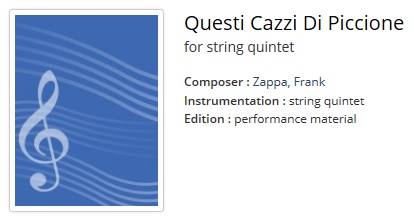 "Questi cazzi di piccione" belongs to the abstract atonal
works. When rehearsing it the string players conducted themselves, using taps to keep the time. Zappa proposed they should do this on stage too.
During the concert you can see that on stage Peter Rundel did conduct. Most scores from "The yellow shark" are available for rent at Schott music (image to the left).
Hopefully they will get more easily available one day. Transcribing things as "Times beach" or "Mo 'n Herb's vacation" from CD isn't rewarding.
The fragment from below is played between 2:15 and 2:19. When I transcribed this in 2022 there were too many uncertainties regarding its notation to do something with it in an
analytical sense. I couldn't guarantee the meter and I wasn't sure who is playing which notes. Only its atonality and its mix of hocketing and counterpoint are clear.
"Questi cazzi di piccione" belongs to the abstract atonal
works. When rehearsing it the string players conducted themselves, using taps to keep the time. Zappa proposed they should do this on stage too.
During the concert you can see that on stage Peter Rundel did conduct. Most scores from "The yellow shark" are available for rent at Schott music (image to the left).
Hopefully they will get more easily available one day. Transcribing things as "Times beach" or "Mo 'n Herb's vacation" from CD isn't rewarding.
The fragment from below is played between 2:15 and 2:19. When I transcribed this in 2022 there were too many uncertainties regarding its notation to do something with it in an
analytical sense. I couldn't guarantee the meter and I wasn't sure who is playing which notes. Only its atonality and its mix of hocketing and counterpoint are clear.
Questi cazzi di piccione, 2:15-2:19 (midi file).
Questi cazzi di piccione, bars 50-1 (midi file).
Questi cazzi di piccione, bars 50-1 (score/transcription).
In 2025 I came across the original score of this piece on YouTube. Now things get more certain:
- Zappa used a 16th note as time unit, where I'm using an eighth note.
- The pizz. Gb in staff 3 of my bar 1 happens in bar 50 of the original score as the last 16th note of the viola part (apparentlty an octave lower).
So the meter should start an eighth note later in my transcription to get the bars presentation the same (hard to tell such things by listening to the CD when downbeats are largely absent).
Otherwise there are no rhythmical differences.
- Part of the cello part got skipped on the CD.
- The violin 2 part goes comparable, but individual notes may differ.
So yet again this is an example of version differences between the score and the CD version, as there are numerous in case of the "L.S.O." and the "The perfect stranger".
Partly this must have been done to make it easier to play (the score version is richer), but there are also differences that don't seem to have a reason.
Questi cazzi di piccione, bars 1-6 (midi file).
Questi cazzi di piccione, bars 1-6 (score).
This second example is the opening, 0:00-0:14 on the CD. The title of this piece is in Italian. Zappa comments: "That means "Those fucking pigeons". If you have ever been to Venice, well, instead of trees, they have
pigeons, and pigeon byproducts. Which is probably one of the reasons the city is sinking. The title was an afterthought. There are all
these knocking sounds in that piece, and the knocking sounds were an invention of the string players. When they tried to learn it, it was very difficult for them to count it,
and keep it even. So one of the guys said, "Well, why don't we just beat time on our instruments in between what we're playing?" - because they rehearsed without a conductor.
When they played it for me with the knocks in it, I told then to leave it in. So you can just imagine those are pigeons."
So what Peter Rundell is saying above about the rhythm of "III Revised" applies to this piece too. The score version I came across in 2025 requires the players to tap on their instruments
too, however, and loudly, but often at different moments than the members of the Ensemble Modern were doing in 1992. Another thing one can notice is the multitude of pizzicato notes, about a third of the total
amounts of notes. This tapping and plucking is characteristic of this piece. Stylistically you've got bars where the accent lies on hocketing with the instruments playing short motifs
or even individual notes. In others bars you can encounter larger melodic lines. In particular at the end several instruments are playing their own melodic lines with the accent thus lying on
counterpoint.
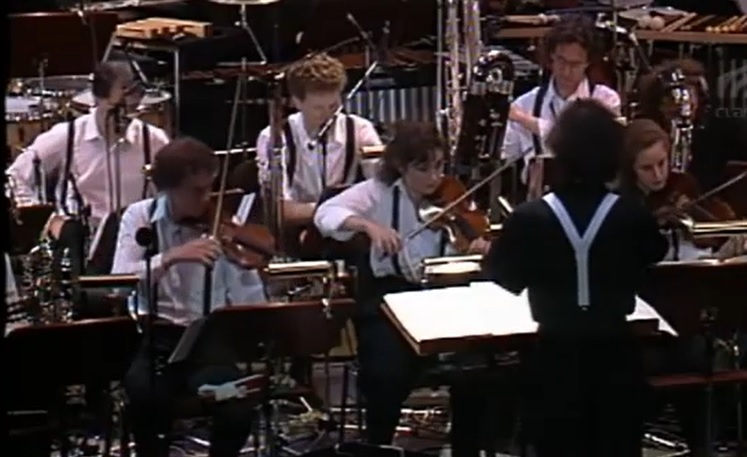
The Ensemble Modern performing Questi cazzi di piccione. On stage this piece ends with the players from the second row
shooting at the quintet with their toy guns.
13. Times Beach III
The next two examples stem from the third movement of "Times Beach". They are two of the fast passages in this mostly adagio movement.
The first example has a bassoon part ticking eighth notes, which makes it better fit for transcribing. When comparing
it to the 1985 performance by the Aspen Wind Quintet, this movement apparently got revised, like the third movement of "None of the above".
Next to the 1993 version, I've also included a transcription from the 1985 execution
of the same fragment, corresponding with 12:19-12:24 on the recording as described above at Times Beach I & IV.
Regarding details, these two versions go pretty different. Another detail that you can hear happening on the 1993 CD is that Zappa
lets the notes of the horn part pop up in two different locations in the stereo field, which I've represented in staves two and three.
The effect is that you're getting the idea that two horns are involved.
Times Beach III, 2:52-2:57 (midi file).
Times Beach III, (same section, 1985 version) (midi file).
Times Beach III, 2:52-2:57 (transcription).
As also mentioned above, I can only approach the following second example straight from CD. So I can't get into details, but it might be clear
nevertheless that it's a good example of free atonal counterpoint. See "Igor's boogie", "Greggery Peccary" and "Envelopes" for other such examples in this
study. Peter Rundel can occasionally be seen conducting during Times Beach, during mvt. III in a slow tempo (ZDF broadcast). Because of that
the fragment below is very likely notated differently in the original score. Probably it's a figure within another meter.
Times Beach III, 3:08-3:13 (midi file, tempo change not included).
Times Beach III, 3:08-3:13 (transcription).
Zappa: ""Times Beach" was commissioned by the Aspen Wind Quintet, and it was in five movements, one of which seemed to be
unplayable at the time that they gave their premiere performance in Alice Tulley Hall in 1985.
Nobody has played it (in full)
since they tried it. The title refers to our special little toxic town-you know, Time's Beach,
the dioxin-infested town that was the first major U.S. environmental disaster where they had to remove everybody out
because of the dioxin." Peter Rundel, conducting the Ensemble Modern: "We had already prepared
other pieces, but we needed something more. The musicians opposed it, but I said maybe
we should try that again. Frank said, "Why not, let's do it", and it became very clear how to play
it. It had no dynamics, no articulation-just plain notes. Frank sang the phrases for us.
Suddenly it became very lively, and the character of the music came out. It was not an abstract kind
of music anymore" (CD Booklet).
14. Food gathering in post-industrial America
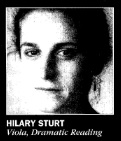 The example below is a section from "Food gathering in post-industrial America", transcribed from the CD.
It should be stressed that this is not how the score looks: Zappa never prescribed the rhythm and pitches
of spoken texts. For constructing a midi file that goes similar to the CD, I need these details nevertheless. Viola player Hilary Sturt is the narrator during
this piece, pronouncing the words with bright pitches, because of which I'm using normal notes instead of crotches. The bars with the ensemble saying
"new perfect America" are different. The pitches are randomly chosen, forming clustered chords. I've only notated some notes on behalf of the midi file. The moments when the harp
is playing the arpeggios must have been indicated in the score. To the right photos of Hilary Sturt and Ellen Wegner, the harpist of the ensemble
(source: CD booklet).
The example below is a section from "Food gathering in post-industrial America", transcribed from the CD.
It should be stressed that this is not how the score looks: Zappa never prescribed the rhythm and pitches
of spoken texts. For constructing a midi file that goes similar to the CD, I need these details nevertheless. Viola player Hilary Sturt is the narrator during
this piece, pronouncing the words with bright pitches, because of which I'm using normal notes instead of crotches. The bars with the ensemble saying
"new perfect America" are different. The pitches are randomly chosen, forming clustered chords. I've only notated some notes on behalf of the midi file. The moments when the harp
is playing the arpeggios must have been indicated in the score. To the right photos of Hilary Sturt and Ellen Wegner, the harpist of the ensemble
(source: CD booklet).
Food gathering in post-industrial America, 0:27-0:59 (midi file).
Food gathering in post-industrial America, 0:27-0:59 (transcription).
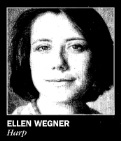 The figures in the 11/8 bar must have been written out in detail in the score as well. These are musical, without improvisation.
It's a rhythmically complicated figure with playing 17 over 11. In its difficulty it can be compared to the 23:24 bar from "T'Mershi Duween" (see above).
The upper melody is moving downwards chromatically, played via parallel major thirds. The bottom staff plays a repeating figure against it, lasting 4/8.
There are probably more notes for staves three and four, played lightly in the background. I've notated what I can hear.
The 11/8 bar can be seen as the main theme from the piece. It returns between 1:19 and 1:38, as well as between 2:12 and 2:37.
The figures in the 11/8 bar must have been written out in detail in the score as well. These are musical, without improvisation.
It's a rhythmically complicated figure with playing 17 over 11. In its difficulty it can be compared to the 23:24 bar from "T'Mershi Duween" (see above).
The upper melody is moving downwards chromatically, played via parallel major thirds. The bottom staff plays a repeating figure against it, lasting 4/8.
There are probably more notes for staves three and four, played lightly in the background. I've notated what I can hear.
The 11/8 bar can be seen as the main theme from the piece. It returns between 1:19 and 1:38, as well as between 2:12 and 2:37.
15. Welcome to the United States
"Food gathering in post-industrial America" and "Welcome to the United States" have their outlines written out, while the details can be improvised. Because of the cliche type of intro from the second track, I've included two examples from it in the Broadway the hard way section. The first is the fanfare type of opening (not part of the score), the second is the opening from the score itself as reproduced in the CD booklet.
16 Pound for a brown
"Pound for a brown" is the oldest piece from "Yellow shark", dealt
with in the Zappa's teens section of this study. He performed it all through his career. It has a main theme, that always has been kept basically the same,
followed by a middle block and/or soloing, ending with an optional reprise of the main theme. Specific for the "Yellow shark version" is a very
strong, newly arranged middle block. In january 2022 Martin Kniss send me a paper he had written in 1999, describing, among others, "Pound for a brown".
This paper is in German, entitled "Between styles - aspects of Zappa's musical esthetics related to some of his original works". About the middle section he writes:
"The middle section is in 5/8. The melody, played by the flute, can't be seen as in five, because
the accents continue to lie on other beats. And there's a percussion part, that disturbs the 5/8 meter by indicating 4/4.
Melody and rhythm don't seem to match, resembling Charles Ives' idea of
marching bands [KS: that is two bands approaching each other, playing different tunes]."
And: "It is remarkable that the percussion parts are not in the score.
[...] Nevertheless, it is not certain whether the tambourine and the drum were added during rehearsals only
as a recourse to the stylistic elements of rock music.
Perhaps Zappa missed the polymetrics of the middle section's melody notated in 5/8 time and the 4/4 time heard in many versions.
The break in the rhythm (bars 26-28) sounds like an annoyment of the percussionist in a marching band,
who suddenly wakes up and finds himself lost with the melody."
Pound for a brown, bars 32-39 (midi file).
Pound for a brown, bars 32-39 (score).
It looks like 5/8 was chosen as just a time unit for this middle block, because it's indeed consistently irregular as it comes to its rhythms. There
are very few points that you could call regular 5/8, perhaps the bass trombone part at the very opening of it and the flute/marimba part during bars 36-38
in the example above. Two bars ahead these last bars get repeated by the bassoon, two octaves lower, an instance of what you might
call classical counterpoint techniques, where voices are imitating each other. The idea of using meters just as time units is also happening during "The perfect stranger".
See the Perfect stranger section for a couple of examples, that are notated in 3/4, without following its downbeat in a normal sense.
I've added the drum beats at the bottom of the example, its presence being correctly pointed at by Martin.
From the perspective of this section from my study, counterpoint, this is a very good example of Zappa applying multiple counterpoint.
The bars from above can be heard between 1:02 and 1:12. It's also an example of Zappa forever trying to reshape his music by re-using sections of earlier compositions
and integrating them in new ones. On this occasion the melodic lines played by the flute (staff 1) are variations upon melodies from
"What's the name of your group", which on its turn is drawing upon a
motif from "Pound for a brown/The legend of the golden arches" from "Uncle Meat". See the 200 Motels and Uncle Meat sections from this study for these last two compositions.
In "The Real FZ Book" Zappa himself is comparing this approach with how Alexander Calder balanced his "mobile" scupltures:
"In my compositions, I employ a system of weights, balances,
measured tensions and release—in some ways similar ... to a
Calder mobile ... A large mass of any material will "balance" a
smaller, denser mass of any material, according to the length of
the gizmo its dangling on, and the "balance point" chosen to
facilitate the danglement."
The following example is the end of "Pound for a brown", to be heard between 2:02 and 2:12. Bars 87-90 are another instance of multiple
counterpoint. The score doesn't indicate dynamics. When you play it without dynamics, this section sound much more wild and dense than on the album
because of the many polyphonic layers in it. During the rehearsals it was apparently decided that for bars 87-90:
- Horn 2 plays lead, so this part becomes the best audible melodic line.
In bar 87 the Ab lasts a quarter note and the D an eighth note, so the rhythm got a little changed.
- Horn 1 got skipped.
- The three 16th notes at the end of bar 90 by the trumpet get accentuated.
- Only the bass clarinet plays the strings of seven 16th notes, the other instruments skip this figure.
Pound for a brown, bars 87-92, album version (midi file).
Pound for a brown, bars 87-92 (score).
The clarinet part has an A natural in the score (staff 3), while the others have an A#. This has to be a writing error, since this
clarinet is also playing parallel with the bass clarinet and trombone in bar 90, so I've corrected this in the example above.
Bars 87-90 might be attributed to F Dorian. Bars 91-92 fade out a little, forming a transition to the next track, that continues in G Mixolydian.
Other examples included in this study concern:
- "Pound for a brown": the main theme.
- "The legend of the golden arches":
the middle section of this composition when it carried a one-time-only different title. Some of the melodic material from the middle block
of this title also returns in the 1992 version.
- "A pound for a brown on the bus": a version with electronically mutated clarinets,
playing in very high registers.
17 Exercise #4 (1992)
"Exercise #4" appears three times in the official catalogue. The set-up of the "Yellow shark" version is as follows:
0:00 Theme 1. A melody in G Mixolydian, played via parallel fourths over a repeating chord (Gsus4 add m7).
0:09 Theme 1 gets repeated, transposed a minor second down.
0:13 Theme 1 on G again in a different shape. Here the example below starts.
In 2015 a tried to transcribe this example from the CD, but in 2022 a got a chance to look at the original score.
Rhythmically it's played in the shape of units of three eighth notes, grouped as 3/8 and two times 9/8 in the score.
In 2015 I grouped this in a different manner, namely as 3/8 and three times 6/8.
0:17 Counterpoint block. Here it's getting irregular. The homophonic and polyphonic writing styles get mixed and
the notes are sometimes forming parts of a diatonic scale, while at other moments it's more atonal. Compared to my 2015 transcription much more details are coming out into to the
open, as well as notes that I didn't manage to hear well. Some minor additions were made during rehearsals.
Like in the previous example, the drum beats aren't in the original score.
The playing around the high A in bar 1 from my 2015 transcription isn't in the score neither. As I'm hearing
it the horns/trombones chord from bar 100 doesn't sound constant right from the beginning. The high bar number "100"
stems from the fact that in 1992 "Exercise #4" didn't have a score of its own. It segues upon "Pound for a brown" without a pause,
just as on the album. It doesn't even get mentioned as a movement, so, from the perspective of the score, "Exercise #4" has become
part of "Pound for a brown". For the CD Zappa chose to mention them as individual pieces anew.
0:29 Theme 2. A motif that gets varied upon. There's a light form of counterpoint included, because the two melodic lines
can move into diverging directories.
0:40 Variations upon the earlier counterpoint block.
0:53 Outro with repeating chords.
1:06 Applause.
1:37 End.
Exercise #4, 0:13-0:25 (midi file).
Exercise #4, 0:13-0:25 (score).
"Exercise #4" premiered as the intro for the "Uncle Meat variations" from the 1968 "Uncle Meat" CD. On that album only themes 1 and 2 are played, much
slower than on the "Yellow shark". "Exercise #4" is not directly related to "Uncle Meat", but stylistically they belong to the same category: modern diatonic
music, not using traditional harmony patterns. Interesting is the "Road tapes, venue #2" version with a 1973 performance. This one actually starts with "Uncle Meat"
variations - that is variations upon the melodic material from "Uncle Meat". The variations as present in the 1969 "Uncle Meat variations" are basically the theme
replayed as a series of different instrumentations. This one features theme 1 from the exercise and has an interlude of its own.
I've included part of this section from the 1973 version in the Uncle Meat section of this study.
18. Get whitey
"Get whitey" is an example of a composition where Zappa is using the
synclavier for playing extremely difficult irregular rhythmic groupings.
The Ensemble Modern succeeded in approaching it. Below are some sample bars from the Bb clarinet part (to be transposed).
See the next Civilization phaze III section for examples of the complete score.

Bars 40-41 with 13:8 and 17:3. The meter is 9/4 all through Get whitey.

Bars 60-61 with 11:9 and 7:6.
As far as possible, the notation is done in a way to ease its readability. The 13:8 figure is notated
in a way that the eighth note or a quarter note is directly visible as a time unit. But sometimes you have to peer a while at a
figure to get its intention. The 17:3 figure is meant as 17 16th notes over 3 quarter notes.

Bars 28-30 with 7:5 and 43:3.
With these last bars you can see that this piece really is a synclavier piece. The septuplet from bar 28 is a normal figure, but 43:3 from bar 30?
To see that it fits one has to start counting with a 64th note as time unit ((2*6)+(7*3)+10=43), indeed played over a period of
three quarter notes. The odd relationship of 6, 3 and 10 gets in the way of any better readable form. A synclavier might play that
perfectly, but humans can only approach something like that. When Zappa did write for humans, as in the "Black page", it features a more normal
form of composing with irregular groupings. Still difficult, but doable to play it accurately.
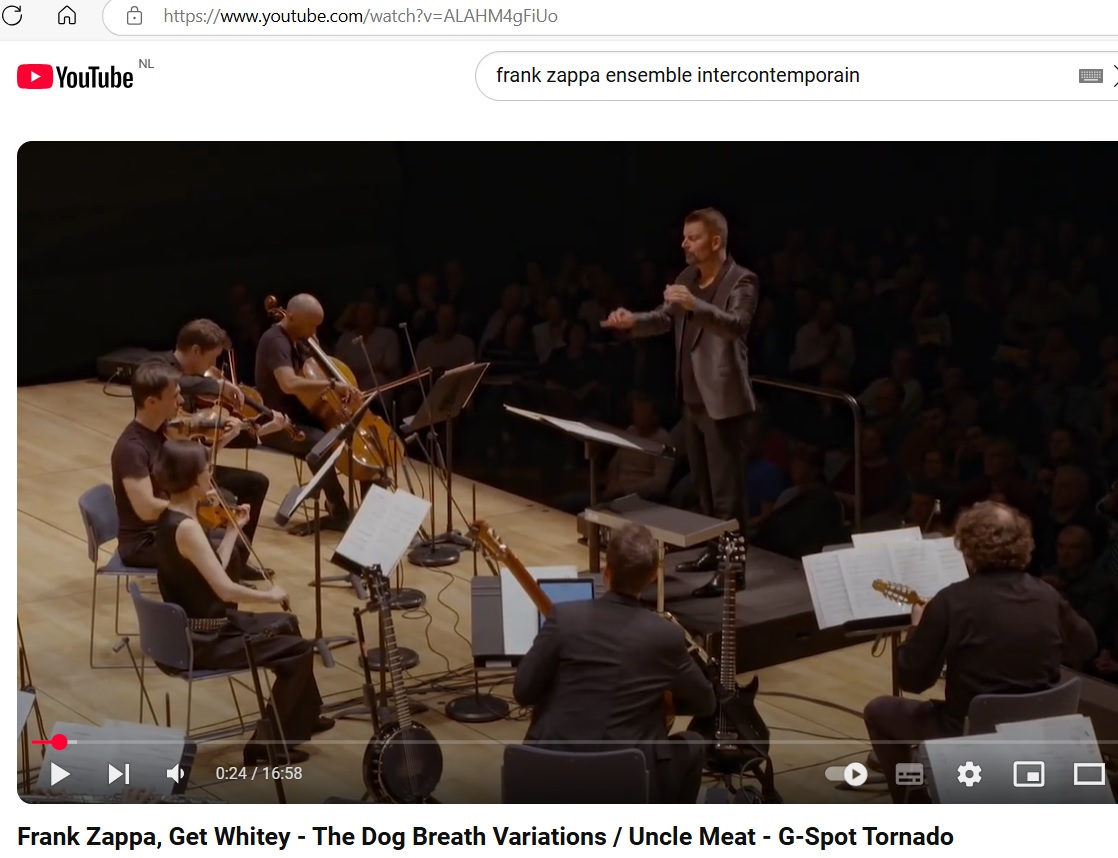
Members of The Ensemble Intercontemporain, performing Get Whitey, september 2018 with Matthias Pintscher conducting.
19. G-spot tornado (1992)
"G-spot tornado" is another synclavier composition. This one
can be performed by humans without much difficulties. See the Jazz from hell section for two examples
"G-spot tornado (1986)". It was performed with dancers on stage.
It appears to have become a favorite. In 1992 it was used for an encore.
At the start of 2014, the Ensemble Insomnio managed to get a permission the play the larger part from the Yellow Shark program anew. Below are two photos
from their concerts at the Lantaren, Rotterdam, and at the Muziekgebouw Het IJ, Amsterdam (photographer unknown). In 2019 they returned to this project,
now playing the entire program. See the Jazz from hell section for a photo of them, playing "G-spot tornado" in Vredenburg, Utrecht, 2019.
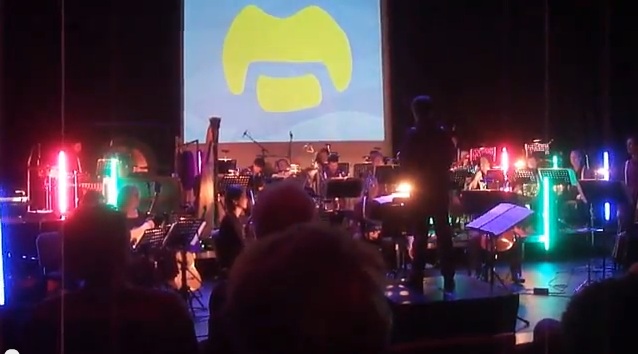
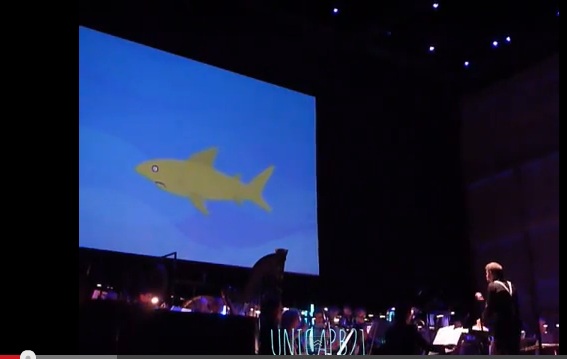
In the liner notes Zappa comments: "During the '91 rehearsals, I came in one day, and a few of the musicians were trying to play that tune.
They really liked it for some reason, and asked whether they could have an arrangement of it for the concert. It was another one of those pieces
done on the synclavier (it appears on the 1986 album, Jazz from hell). I printed out the data, turned it over to Ali [Askin], and he ochestrated it. The rest is history."
Below are two examples from Ali's arrangement. As always, more happened than orchestrating only, the 1986 and 1992 versions aren't identical.
G-spot tornado, 0:12-0:18 (midi file).
G-spot tornado, 1:38-1:45 (midi file).
G-spot tornado, sections (score).
The first example contains bars 13-18, to be heard between 0:12-0:18 on both the "Yellow shark" and "Jazz from hell".
This is part of the A-section. It's a lead melody played over a bass counterpoint line, following B Dorian/Mixolydian (the D and D# are used next to each other).
Apart from the percussion part and the instrumentation, the two versions are the same at this point.
The second example contains bars 97-102, to be heard between 1:38-1:45 on "The yellow shark" and 1:35-1:42 on "Jazz from hell".
Now you're getting at more serious differences:
- Bar 97: the accent on "Jazz from hell" lies on the bass line, while the descant prevails on "The yellow shark". At this point
two 2/2 bars got combined to one 4/2 bar in order to notate it in combination with an 11:8 figure for the percussion, not present like this
on "Jazz from hell". As also noted on page 84 of Daniel Schröder's book, it briefly breaks the basic rhythmic pattern from the first example.
- Bars 98-102: much of the bass counterpoint line of section B from "Jazz from hell" got skipped on "The yellow shark". Here it's a melody, played
via parallel fifths, with percussion only.
Other tracks from EIHN
Apart from the intro, all titles from "The yellow shark" know scores. Most are for rent on the list of Munchkin Music at www.zappa.com.
"EIHN" is a combination of composed music, themes made up on the spot and improvisations. Some compositions, like "T'Mershi Duween",
are also on the Munchkin Music list.
- "Strat Vindaloo": this title features members from the Ensemble Modern,
improvising Indian music with Zappa and Shankar. See the previous documentaries section.
- "Amnerika": See the Civilization Phaze III with a vocal version from around 1983
and some samples from 1992.
The left menu of this site has a section with the tracks that have appeared on the three Ensemble Modern CDs with music by Zappa, 42 in total. Many
note examples from these pieces are dealt with spread out over this study. In case of their last "Greggery Peccary and other persuasions" CD
it concerns the following titles, all of them included in this study:
- Moggio: The man from Utopia section.
- What will Rumi do?: above.
- Night school: Jazz from hell section.
- Revised music for low budget orchestra: Orchestral favorites section.
- The beltway bandits: Jazz from hell section.
- A pig with wings: Civilization part III section.
- Put a motor in yourself: idem.
- Peaches en regalia: Hot rats and Tinsel town rebellion sections.
- Naval aviation in art?: The perfect stranger section.
- The adventures of Greggery Peccary: Orchestral favorites section.
- Does this kind of life look interesting to you? (hidden bonus track): 200 Motels section.
